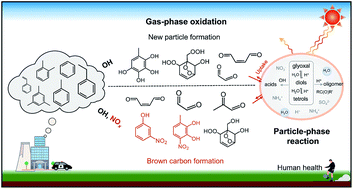Secondary organic aerosol formation from monocyclic aromatic hydrocarbons: insights from laboratory studies
Abstract
Monocyclic aromatic hydrocarbons (MAHs) are key anthropogenic pollutants and often dominate the volatile organic compound emissions and secondary organic aerosol (SOA) formation especially in the urban atmosphere. To evaluate the environmental impacts of SOA formed from the oxidation of MAHs (aromatic SOA), it is of great importance to elucidate their chemical composition, formation mechanism, and physicochemical properties under various atmospheric conditions. Here we seek to compile a common framework for the current studies on aromatic SOA formation and summarize the knowledge on what has been primarily learned from laboratory studies. This review begins with a brief summary of MAHs' emission characteristics, followed by an overview of atmospheric degradation mechanisms for MAHs as well as gas- and particle-phase reactions involving aromatic SOA formation. SOA formation processes highlighted in this review are complex and depend highly on environmental conditions, posing a substantial challenge for theoretical description of aromatic SOA formation. Therefore, the following issues are further discussed in detail: the response of gas-phase chemistry and aromatic SOA mass yield as well as composition to NOx levels, particle-phase reactions and molecular characterization of aromatic SOA in the presence of acidic sulfate, and physicochemical processes of SOA formation involving gas- or particle-phase water. Building on this current understanding, available experimental studies on the effects of environmental conditions were explored. A brief description of the atmospheric importance of aromatic SOA including their optical properties and health influences is also presented. Finally, we highlight the current challenges in laboratory studies and outline directions for future aromatic SOA research.

- This article is part of the themed collections: Atmospheric chemistry and SDG13: Climate Action- chemistry of greenhouse gases, 2022


 Please wait while we load your content...
Please wait while we load your content...